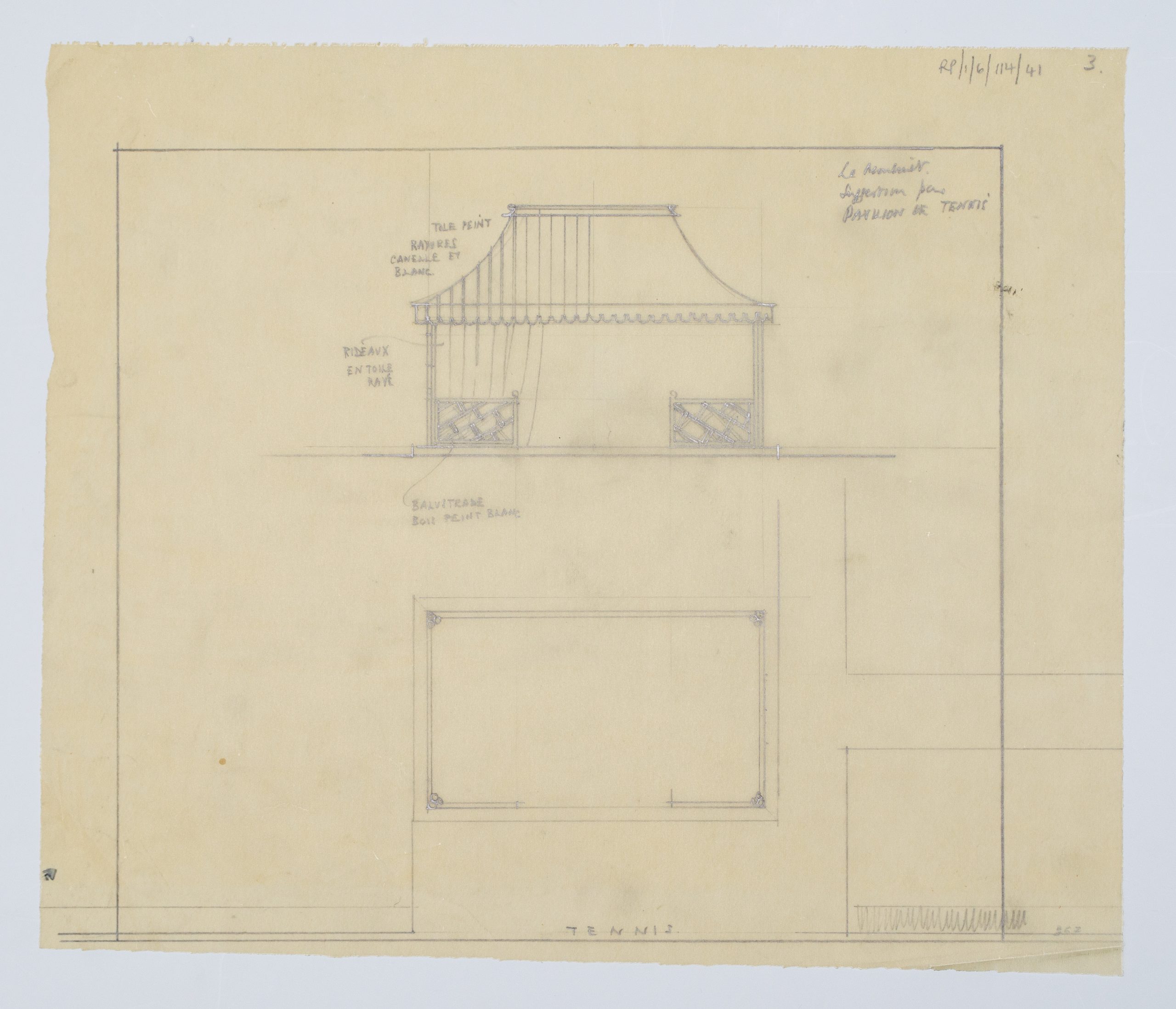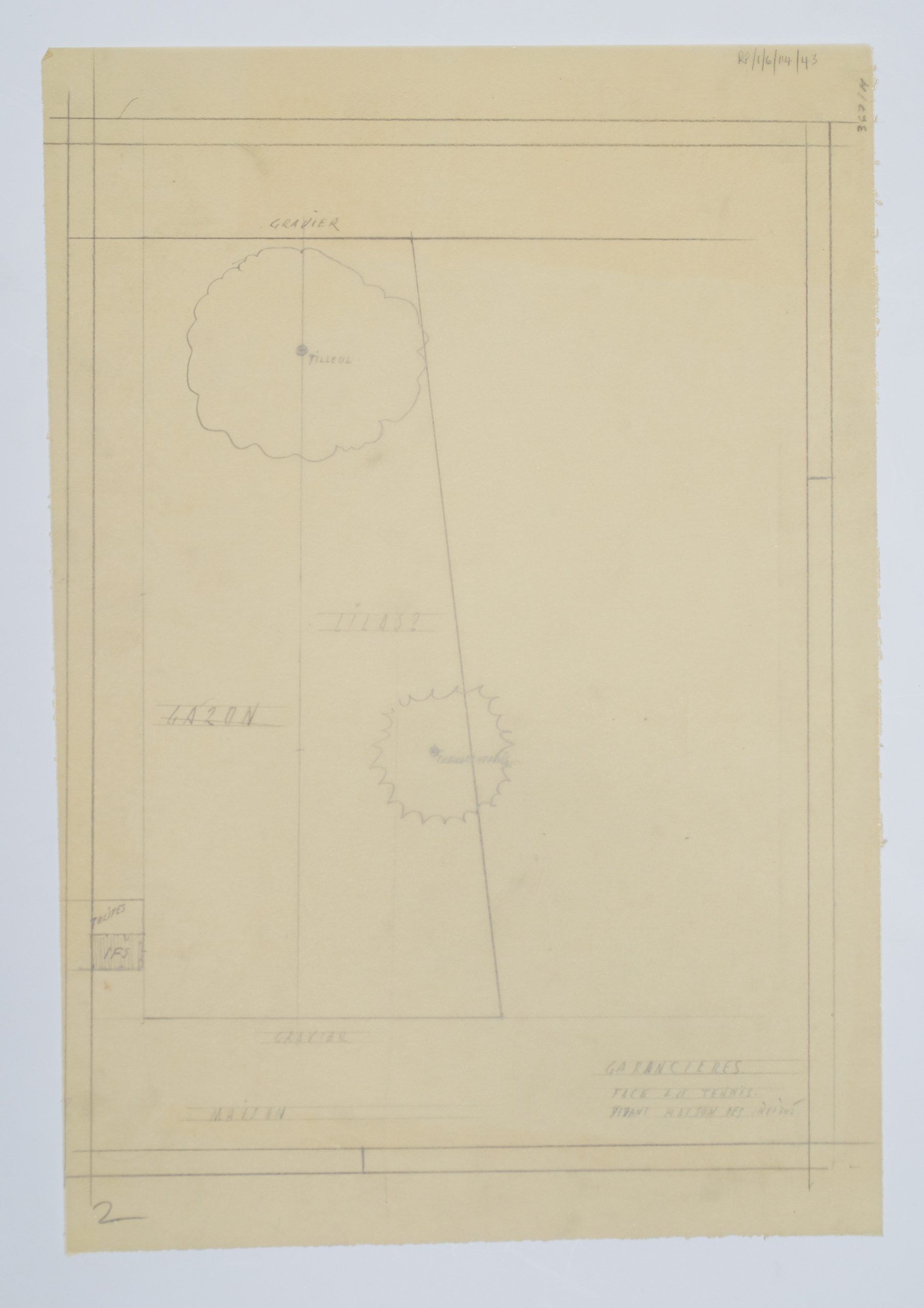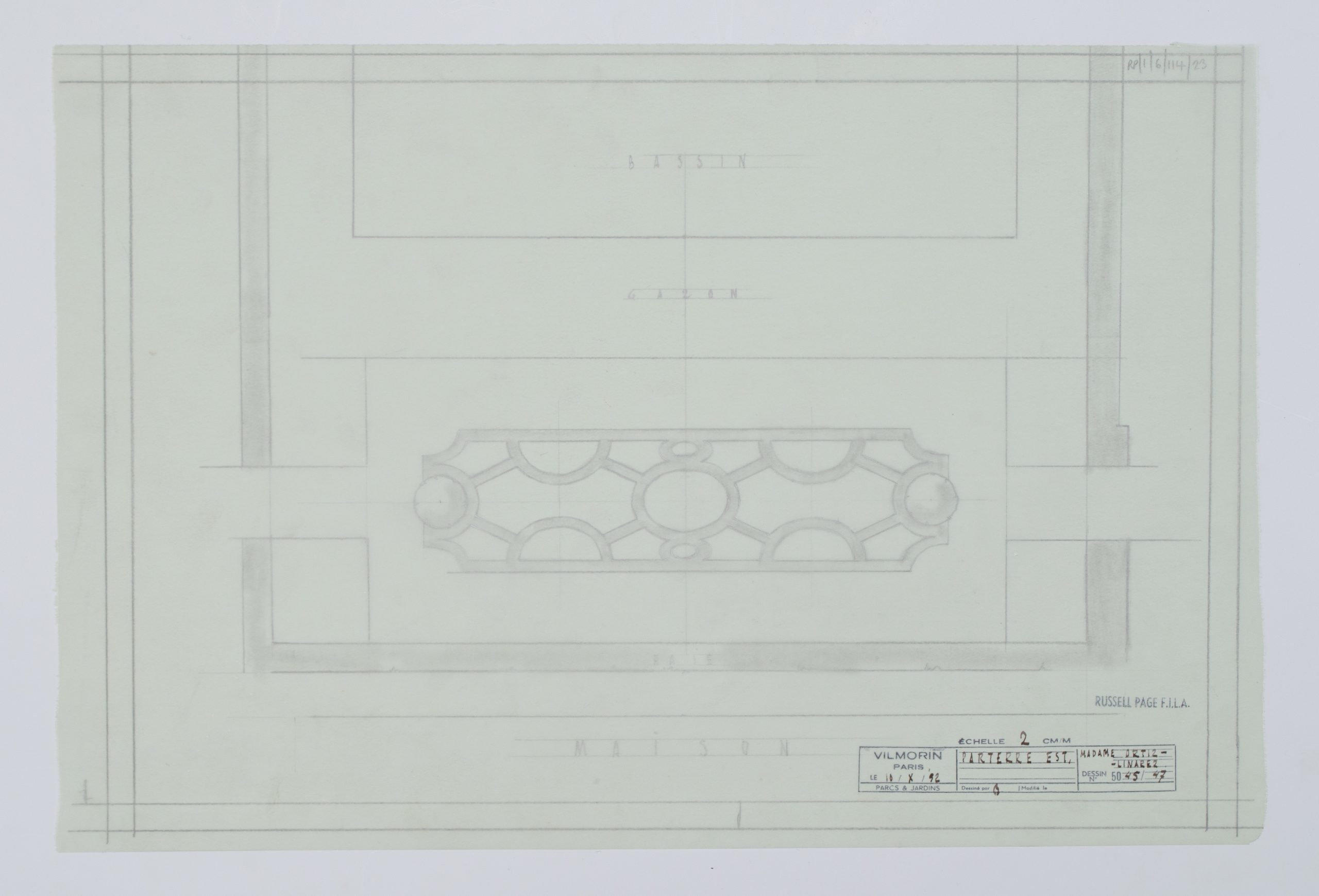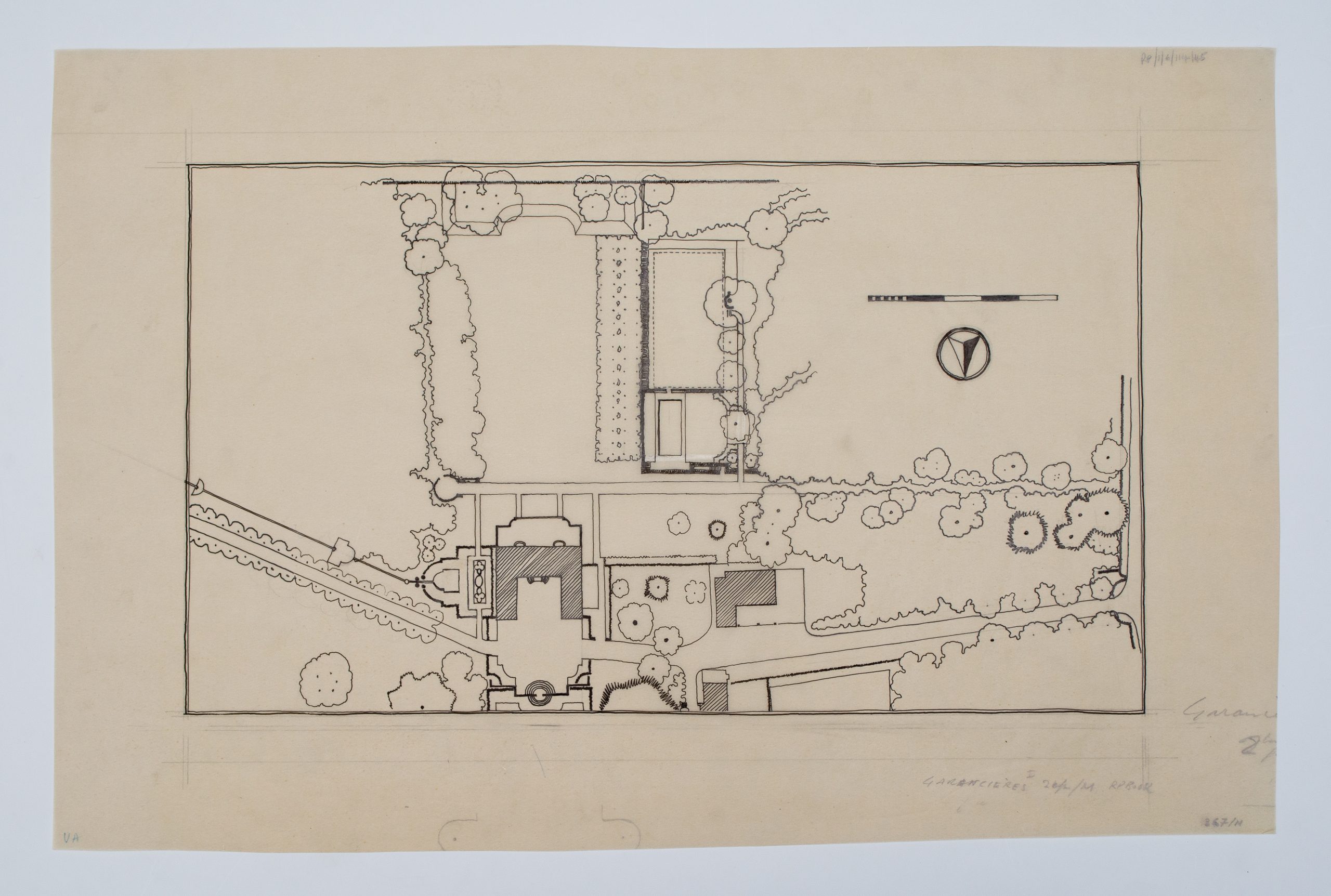At Le Moulinet in north-central France, a small Louis XV château with huge gardens, Russell Page demonstrated his remarkable skill as a landscape architect, cleverly reconciling the disproportionate scale of house and grounds.
Château du Moulinet, Garancières, Yvelines, France
1950 to 1953
Archive of Garden Design Ref: RP/1/6/114
For Russell Page, the appeal of the garden at Le Moulinet lay in its remarkable scale in relation to the château: “I do not know another eighteenth-century house so small, almost miniature in all its parts, with so large and spacious a garden scheme as this must have been” (Page 269). The plans give a sense of the vastness of the grounds (most especially RP/1/6/114/2 and RP/1/6/114/4); the u-shaped house appears tiny compared to the surrounding garden. Page’s response was to break up the plot into distinct areas while keeping vistas open and uninterrupted: “It was important that no single unit should appear too large and that one would always be drawn into each part of the garden in order to see what lay beyond” (269).
The château, around 30 miles west of Paris, was built around 1750. Only one room deep, two wings projected to the north, creating a courtyard to the rear of the property. Around 1950, Page was asked by Jorge Ortiz Linares, Bolivian ambassador to France, and his wife to transform its neglected gardens. (Page would later design gardens in Switzerland and Spain for their son Jaime Ortiz Patino.) He continued to work there until the mid-1950s.
A significant number of drawings for the project survive in the archive, so that each element of the scheme is documented to some extent. As well as plans that show most of the overall site, there are also designs for parterres, pools, a potager, a flower garden and stone staircase. It was by creating these separate areas, often demarcated and enclosed by pleached lime trees, that Page established a sense of balance between the garden and the house. The three-dimensional renderings (of the château and a tennis pavilion), are a reminder of Page’s early training at the Slade School of Fine Art.
Any reading of these plans is greatly assisted by Page’s commentary on the garden in The Education of a Gardener, where he wrote about it at length (photographs of it also appear). He described the stretch of land to the back of the house (see RP/1/6/114/2) as follows:
When I first saw the Moulinet there were still a few traces of a fairly elaborate Louis XV formal layout; but time had reduced these to a series of simplified cascades along a narrow watercourse which runs parallel to the entrance drive and a large pièce d’eau lying on the north axis of the house, some hundred yards from it and at a considerably lower level. This pool lay in a neglected orchard which had been originally a kitchen garden. Still farther away in the same direction a semi-circular bosquet of pleached limes terminated the main axis at the limit of the property. […]
The formal pool, newly cleaned and edged with stone, was very large in scale and demanded quite a formal setting and, at that, one in which perspective should play its part to relate the small scale of the house to this relatively large sheet of water and the wide skies above it. The first thing to do was to give the pool a spacious and level setting of grass. This involved considerable levelling. First of all I had to make a court from a sloping lawn. Then the lawn itself had to be broken by two shallow banks with steps to bring it down to the level of the pool. Beyond the pool the ground was again graded down to another small circular pool which had once marked the centre of the kitchen garden. Beyond this again a central path continued to the half-circle of old pleached limes at the farthest end of the garden.
The next stage was to frame these levels of grass and water. This I did by an extensive planting of hornbeam hedges now some ten feet high. After running straight down either side of the first sloping lawn, they widen to form semicircles round a huge poplar and a young forty-foot specimen which I planted to balance it. Level with the large pool, the hedges are set still farther back on each side and here I doubled them to enclose a wide grass walk shaded by two lines of clipped limes. Then, beyond the pool, they return towards the centre and continue down either side of the next sloping lawn which is considerably narrower. Finally, beyond a small round pool, the perspective is reduced to the width of a gravel path, bordered by philadelphus and old-fashioned paeonies (sic).
I planted groups of wellingtonias, sophoras, willows and scarlet oaks in the right foreground of the composition to balance eventually an existing clump of large trees to the left, and beyond and below, rows of lime trees have been planted behind the hedges, to be clipped or not when they are large enough. The site of the former kitchen garden at the far end of the perspective has been planted as a wood of lime trees with an undergrowth of hazels, hornbeam and wild strawberries (267-8).
Page then described his design for the area in front of the house to the south:
The south façade of the house, with its characteristic curved cornice, its charming fenestration and its carved figure set high in a niche, gave on to a rough meadow sloping upwards to a low hedge cutting the sky. To the east side a wood comes close to the house, while to the west a similarly planted wood lies a hundred feet further back. The formality and rigid symmetry of the house looked lost in this quite unbalanced setting, so once again it was necessary to find a simple but drastic solution.
The first thing to do was to place the house firmly in its setting by a simple paved terrace whose low retaining wall repeats the curved sweep of the cornice. This gives, by three steps, on to a space of level ground and a wide path running parallel and close to the house clear from one wood to the other. Then the meadow had to be regraded to make a perfectly plain lawn, sloping upwards to the horizon but less abruptly than before. At the far end a shaped grass bank rises to the original level at the boundary.
In order that the house should be in the centre of the composition, I planted, on the right of this lawn, four rows of lime trees, parallel to and at the same distance from the house as the wood on the left, and behind these I set another high hornbeam hedge to conceal a tennis court and a swimming pool (268-9).
Page does not write about a formal parterre and small basin to the east of the house, although presumably they were new additions (they are not marked on RP/1/6/114/1 but are on RP/1/6/114/2). Nor does he reference the new kitchen garden which, as he does explain, was moved from the north axis (see RP/1/6/114/17 and RP/1/6/114/33). A flower cutting garden was incorporated close to it, several suggested designs for which survive (see: RP/1/6/114/12 to RP/1/6/114/16; RP/1/6/114/19; RP/1/6/114/22; RP/1/6/114/25; RP/1/6/114/34; RP/1/6/114/36 and RP/1/6/114/42).
The challenges presented by the grounds at Le Moulinet were significant, and took some time to resolve. The result, however, was a series of spaces in which clear lines, reflective pools and clever planting remained entirely in sympathy with the original 18th-century château and its setting. A remarkable example of this is Page’s design for the new staircase on the north axis (RP/1/6/114/11):
There is always something just and exact to be sought for in any garden composition and in one detail, in this garden, I had a curious proof of this. I puzzled for a long time as to how to arrange the stairway which had to lead down into the garden from the entrance court in front of the house, replacing an untidy grass bank. Looking down from the house to the larger scale of the garden, it seemed as though any large simple flight of steps would do, but looking back from the garden towards the house, with its tiny wings and miniature pediment, it was clear that such a large flight of steps would be entirely out of scale. Finally I worked out the circular steps […], and when we came to dig the foundations for them we found in exactly the same spot the original foundations for a circular staircase of exactly the same diameter.
Whatever the contours of the site, the underlying shapes of a garden can scarcely be too simple. This rule holds good whether you are making a severely architectural garden extending from a formal house and carried out with a limited range of plant material or whether you want a frame, formal or informal, for a rich and varied planting (Page 269-70).
Literature
Page, Russell. The Education of a Gardener. Harvill, 1994.
van Zuylen, Gabrielle and Marina Schinz. The Gardens of Russell Page. Frances Lincoln Ltd, 2008.
Related material in the Archive of Garden Design
RP/1/31: Le Moulinet, Sketch of Garden Steps, June 1951.
Related material elsewhere
There are photographs of the château du Moulinet (with comments by Page on the backs) in the RHS Lindley Library reference collection (PAG/2/1/9).







































